When it comes to single-action revolvers, commonly referred to as cowboy guns, America’s appetite seems alive and healthy. Nostalgia plays a part in this interest, and so does Cowboy Action Shooting. We tested three revolvers whose forebears may have vied for sales in the Old West beginning in 1873. The Taylor’s & Company Devil Anse is named after a famous American gunner and is a Colt Single Action Army clone. The Taylor’s & Company Remington 1858 conversion is a reproduction of the typical conversions performed on original cap-and-ball revolvers. This revolver retains the ability to fire black powder in the cap-and-ball fashion if the shooter purchases a black-powder cylinder. We also tested a reproduction of the Smith & Wesson Schofield revolver. This is a clone of Smith & Wesson’s break-top revolver that was intended to compete with Colt’s original SAA revolver. The Smith & Wesson was successful in overseas sales and had some success in the states as well. It should be stressed that there is no clear purpose for these handguns, other than pride of ownership and recreational shooting. Our research indicates the SAA type is preferred above all others in Cowboy Action Shooting, although a few use competing types.
How We Tested
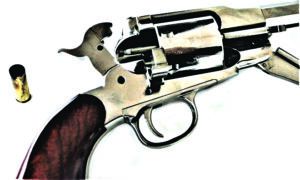
We were able to get together six types of ammunition for the test. We used the Winchester 255-grain round-nose load, Black Hills Ammunition’s 250-grain cowboy load, Remington’s 230-grain jacketed hollow points, a few Blazer 200-grain jacketed hollow-point loads, and a handload using the MattsBullets.com 255-grain bullet and Titegroup powder for 783 fps. Interestingly, the Remington, with its 8-inch barrel, developed the lowest velocity of the three revolvers. Also, we attempted to use 45 Colt Aguila loads, but we found the ammo’s low report and light recoil concerning. When we clocked three rounds of this on the chronograph, we found velocities of 415 fps, 360 fps, and 390 fps. Cowboy loads usually clock about 650 fps, so we felt there was some danger of a bullet sticking in the barrel. The Aguila loads were much too light. We used the handloads primarily during offhand firing, setting off 36 rounds in each revolver. We fired quickly, firing with one hand at 5 and 7 yards and two handed at 15 yards.
Read on to discover which revolver you may enjoy the most and to see which one fits your style.
Gun Tests Grade: B
$638
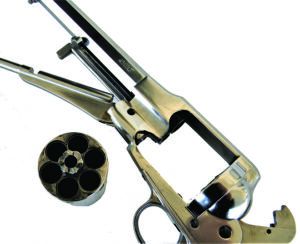
We did not seek out a nickel-plated revolver, but the opportunity was there, and the price was fair. We learned that during times of shortage, shops that seldom stock single-action revolvers now have two or three. Folks have been hungry for handguns, and the single actions have been the only big-bore handguns of any type the shop owners were able to obtain in the recent past. We are not certain of the wisdom of defending the homestead with such old technology, but then you could do worse. These handguns are reliable and hit hard. Some like the absolute safety of a revolver with the hammer resting on an empty chamber. With this in mind, we added 45 Colt defense loads to the test program.
| Action Type | Single-action revolver |
| Overall Length | 13.25 in. |
| Overall Height | 5.2 in. |
| Minimum Width | 1.5 in. |
| Weight Unloaded | 45.0 oz. |
| Weight Loaded | 47.5 oz. |
| Barrel | 8.0 in. |
| Capacity | 6 |
| Frame | Steel |
| Front Strap Height | 2.5 in. |
| Rear Strap Height | 3.0 in. |
| Grips | Walnut |
| Grip Thickness | 1.5 in. |
| Grip Circumference Max | 6.5 in. |
| Front Sight | Fixed Post |
| Rear Sight | Topstrap groove |
| Sight Radius | 12.0 in. |
| Trigger Pull Weight Single Action | 6.0 lbs. |
| Trigger Span SA | 3.25 in. |
| Warranty | 1 year |
| Telephone | (540) 722-2017 |
| Website | TaylorsFirearms.com |
| Made In | Italy |
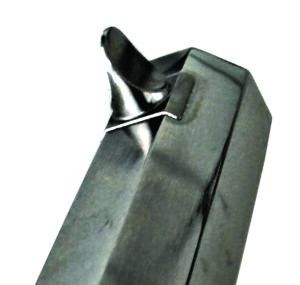
Back in the day, the Remington was the primary competitor to the Colt revolver, and, in fact, the solid strap was seen as an advantage to the open-top Colt. Colt designed solid-strap revolvers prior to Remington, but they were not popular. The 1858 revolver was manufactured in great numbers. After the Civil War, a conversion process was invented to convert the cap-and-ball revolvers to cartridge use. A recoil shield with a loading gate usually incorporated some type of firing pin and an ejector rod was added. Most also retained the original seating ram and could easily be converted to using loose powder, ball, and caps. The original Remington was converted to a five-shot cylinder and a 46-caliber rimfire cartridge. The Taylor’s replica is a six-shot 45 Colt, taking some liberty with originality but making for a far more practical firearm. As a side note, most of the early rimfire cartridges and even the first centerfire cartridges were far less powerful and effective than the 44-caliber cap-and-ball revolver. By the time we had the 44-40 WCF and the 45 Colt, the revolvers could handle the rounds. Our research indicates that at a time when quality new production revolvers cost around $25, an existing cap-and-ball revolver could be converted for $5 to $10. Many of these revolvers were in use at least into the early 1900s.
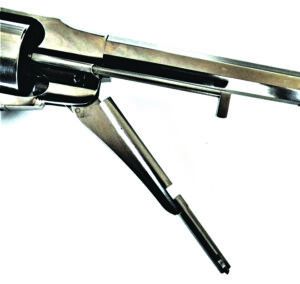
The Remington clone is a large handgun with an 8-inch barrel, tipping the scales at 45 ounces unloaded. The fit and finish are flawless — one rater said beautiful — something seldom heard with a handgun costing less than $700. The revolver features a post front sight and a typical trough for the rear sight. The Remington 1858 conversion revolver features a nicely machined recoil shield incorporating a loading gate and firing pin. The revolver is placed at half cock to load and unload cartridges. The revolver indexes with a slight click as you load the chambers. Like other single-action revolvers, the hammer must be cocked for each shot. A single trigger press fires the handgun. Unloading spent cases is simple enough, but the process requires a certain manual of arms. The revolver is placed on half cock and the loading gate opened. The ram rod is lowered but not to the fully engaged position, or it would lock the cylinder up. As the ram rod is lowered, an ejection rod is exposed. This rod’s end toward the muzzle fits into a slot in the ram rod. It is turned outward and then pressed to the rear to eject spent cartridges. The ejector rod is not spring loaded. It must be manually returned to position after each cartridge case is ejected. This is a time-consuming process, but then one purchases this revolver in part because you enjoy manipulating these handguns.
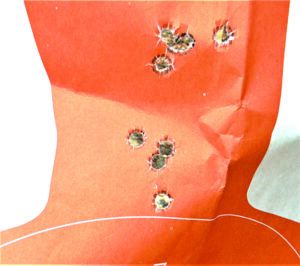
The cross section of the handle is smaller than the other revolvers. It is comfortable to handle and fire, but it doesn’t have the natural point of the Colt type. Trigger compression is clean enough at 6 pounds even. The hammer isn’t difficult to cock for firing. A feature we did not care for was a safety set into the hammer. This safety is turned with a supplied tool to prevent the revolver from firing. We suppose this earns import points. Small parts tend to wear with recoil, and we just don’t like this device, while it presented no difficulty. The Remington cannot be fully loaded and left at ready because the hammer nose and firing pin would rest on the cartridge primer. Load a cartridge, skip a chamber, load four cartridges and cock and lower the hammer on the empty cylinder if the revolver isn’t to be immediately fired.
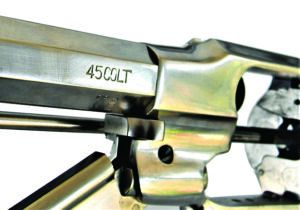
The Remington clone is a light kicker and is easy enough to use. The revolver lined up on target, and the raters enjoyed firing it. It did not handle as well as the Devil Anse SAA clone, however. In firing from a solid position using an MTM firing rest, results were excellent. As for sight regulation, these handguns were designed to fire high at short range in order to give soldiers and lawmen a chance of connecting with rebel cavalry or an Indian war pony at 100 yards. The Remington struck about 3 inches high at 25 yards. The good news is the revolver is very accurate by any standard. A 45-ounce revolver firing a 675 fps load just doesn’t recoil much, and the trigger is smooth, if not light. Even the Remington 865-fps load was pleasant to fire. Several groups were under 2 inches, the best of the test.
Our Team Said: The raters enjoyed firing the revolver. It is historically accurate, save for chambering in the “modern” 45 Colt cartridge. We feel that the Remington offers virtually the same shooting experience as an original. We did not test a cap-and-ball cylinder, but this is a plus for some shooters. Those who enjoy firing black powder would find the cap-and-ball cylinder to be a good feature. The Remington delivers on fun shooting and authenticity. Compared to the other revolvers, however, the spent-shell ejection system is archaic and after a time, tiring. We rated the otherwise excellent Remington down a full grade on this.
45 Colt Range Data
All groups were fired at 25 yards from a benchrest position using an MTM Universal Shooting rest. We used a Competition Electronics Pro Chrony to measure velocities. The first screen of the chronograph was 10 feet from the muzzle of the firearm.| Black Hills 250-grain Cowboy | Taylor’s Devil Anse | Taylor’s Remington 1858 | Cimarron Schofield |
| Average Velocity | 699 fps | 675 fps | 714 fps |
| Muzzle Energy | 271 ft.-lbs. | 253 ft.-lbs. | 283 ft.-lbs. |
| Smallest group | 1.8 in. | 1.6 in. | 2.9 in. |
| Average Group | 2.4 in | 2.1 in. | 4.0 in. |
| Winchester 255-grain RNL | Taylor’s Devil Anse | Taylor’s Remington 1858 | Cimarron Schofield |
| Average Velocity | 694 fps | 671 fps | 688 fps |
| Muzzle Energy | 273 ft.-lbs. | 255 ft.-lbs. | 268 ft.-lbs. |
| Smallest Group | 2.5 in. | 2.0 in. | 3.8 in. |
| Average Group | 2.9 in. | 3.3 in. | 4.4 in. |
| Remington 230-grain JHP | Taylor’s Devil Anse | Taylor’s Remington 1858 | Cimarron Schofield |
| Average Velocity | 865 fps | 857 fps | 880 fps |
| Muzzle Energy | 382 ft.-lbs. | 375 ft.-lbs. | 395 ft.-lbs. |
| Smallest Group | 2.7 in. | 2.5 in. | 3.6 in. |
| Average Group | 2.9 in. | 2.9 in. | 4.2 in. |















I have the steel Pietta 1858 44 in the standard 7.5″ and the hard to find Pietta 12″ stainless steel Bison (Gunbroker) both black powder but I have a 5 round 45 Colt conversion cylinder that works perfect in both. When loading black powder, I usually just fill the chamber to the top then pack it down with a .454 or .452 lead ball.They weigh in at around 145 grains if I remember correctly. I’m over 1100 fps in the 12″ barrel and over 1000 fps in the 7.5. The seem to handle those hot loads just fine. When I convert over to 45 Colt, I use my cast 212gr hps loaded for cowboy at around 700 fps. Both are very accurate with both loads one-handed is what I usually shoot from them, the same as my 1873 SAA Uberti with cowboy loads. Lots of fun with those historic Italian-made clones!
Since this Remington was made in Italy, is it a Uberti or Pieta?